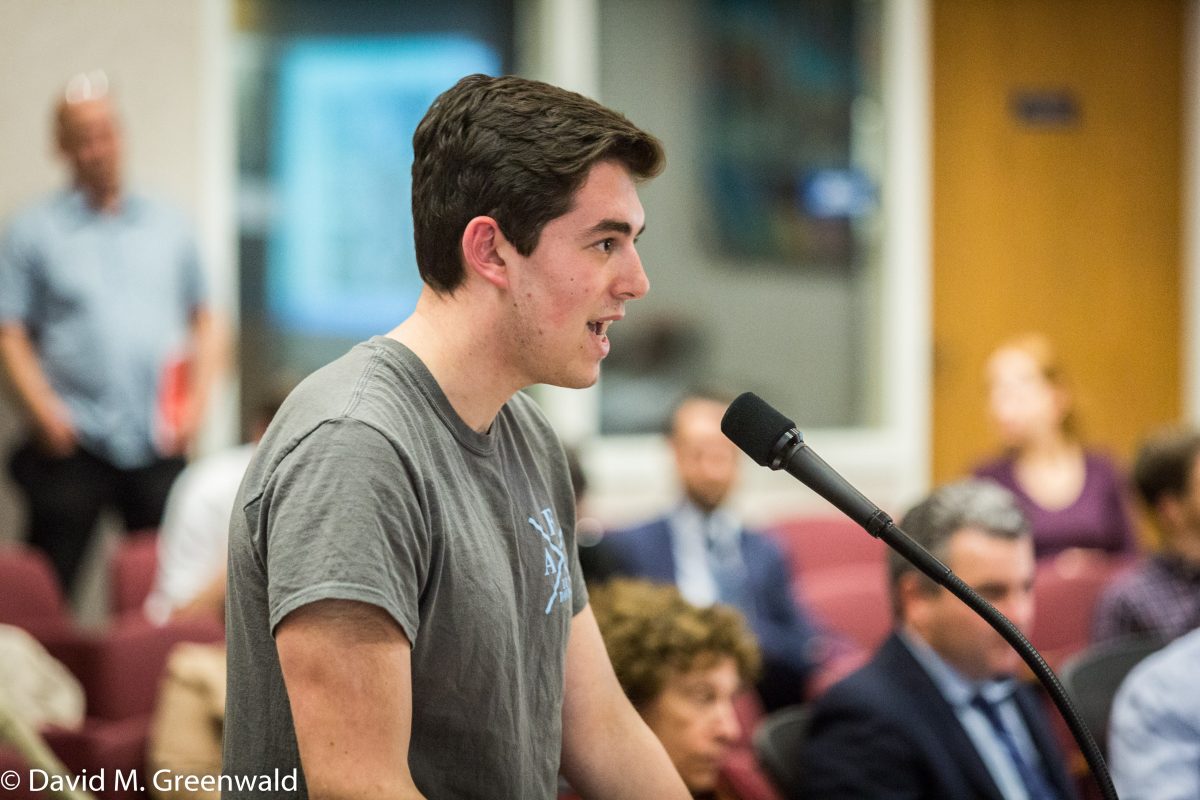
For all of the debate and discussion over the last nearly two years over Lincoln40, the only real question on Tuesday night was whether the council would end up changing the mix on the affordable housing package to 15 percent from the proposed 12 percent and how much the developer would end up paying for the overcrossing.
In the end, the council decided to stick with the 12 percent affordable housing number, opting to go “deeper” by way of a deeper subsidy, rather than “wider” as in more beds. The council got the developer to agree to go up to a $1 million contribution on the overcrossing.
Council then minutes before midnight voted 5-0 to pass Lincoln40 on a motion made by Lucas Frerichs and seconded by Rochelle Swanson.
There were a number of public comments, and during the actual item 32 people spoke, with only Rhonda Reed, Linda Deos, Donna Russell, Nancy Price and Eileen Samitz speaking out against the project and with no opposition coming from the neighborhood.
Robert Canning, speaking on behalf of the Old East Davis Neighborhood Association, which remains neutral, thanked the applicants for their extensive and early outreach efforts – a sentiment echoed by the council, which showed that effective early outreach can allay neighborhood concerns if done in a proactive manner.

Councilmember Will Arnold raised the issue that his preference would be to go to 15 percent affordable, saying “even if it means an even split” in the low versus very low units. He argued, “The more beds the better.”
He also argued for the contribution from the developer for the overcrossing to be $1 million rather than $865 thousand.
However, Rochelle Swanson pushed back on the affordable housing. She argued, “I would like us to preserve (the 12 percent very low affordable housing plan).
“This being so cutting edge, and that we finally have a program and a company with a philosophy to understand and really listen to the fact that students who don’t qualify magically for a ‘A’ affordable housing get left in the lurch and that’s really disappointing,” she said praising their proposal as “really progressive.”
Mayor Robb Davis echoed her concerns, stating, “My preference is we stick with the plan and we go deeper.”
Deep matters,” he said. “I think we want to go deeper because I’m afraid we’re going to miss the population that’s really in bad shape.”
“We need units,” he said. “Our capital ‘A’ affordable programs in the city exclude students.”
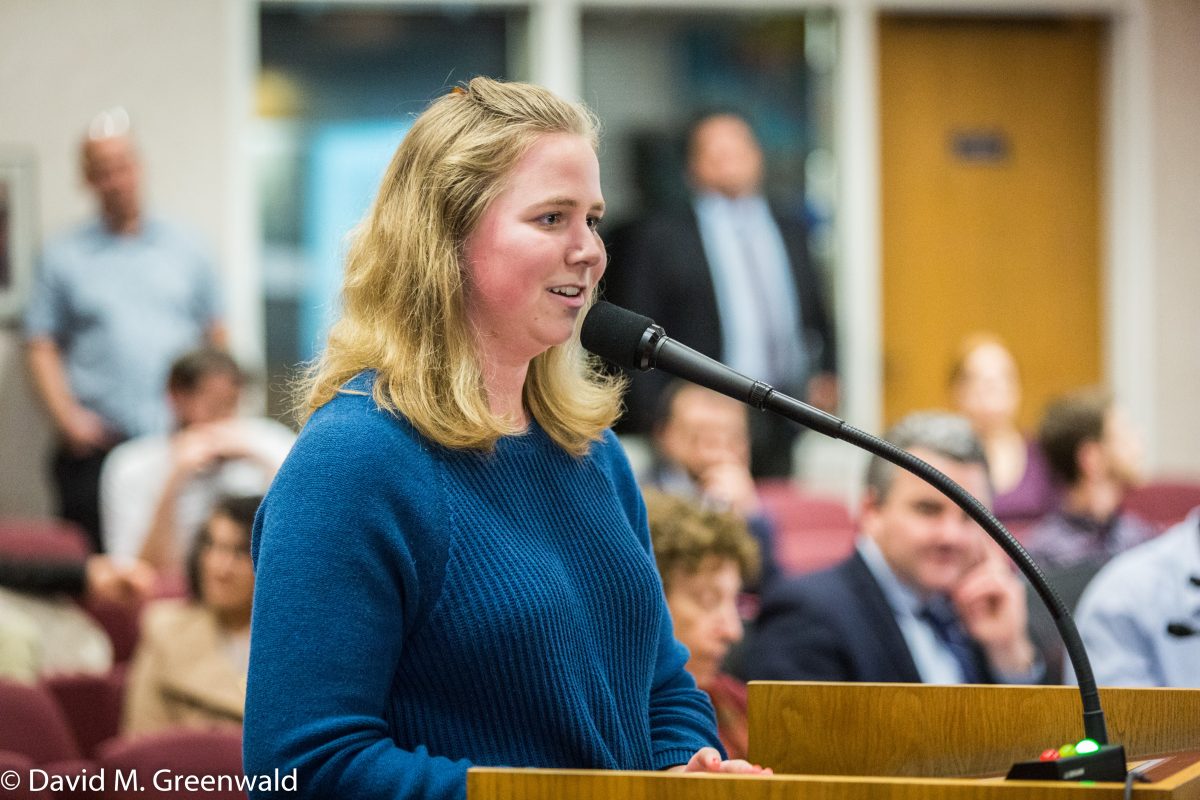
He added speaking to the developer who had originally proposed in-lieu fees, but listened to council and community concerns: “I’m glad you took up the challenge, I think it’s the right thing to do.”
Ultimately the council stuck with the 12 percent plan, allowing for more very low affordable beds. In addition, the developer agreed to the additional contribution to the overcrossing.
The breakdown of those costs are that the ATP (Active Transportation Program) Grant will fund $3.335 million of the $6.67 million overall costs. The developer will now contribute a flat million up from $867,500 previously. Then $442,000 will come from Roadway Development Impacts Fees. Finally, $2 million less $133,000 or so picked up by the developer will come from the city, also from Roadway Development Impact Fees that 
have been collected into a fund.
Perhaps the most interesting portion of the discussion came when Mayor Pro Tem Brett Lee pushed his colleagues to pledge that, after this project, they need to look at a broader range of housing options.
“There are a variety of needs for housing,” he said. “Some relate to students specifically, some are workforce housing needs, some are retirees, some relate to for sale, some relate to rental.”
He said they have approved around 3000 to 3500 beds in the city in projects geared toward students. He suggested that his colleagues pledge to reconsider future student housing projects.
“I think we’ve done our fair share toward addressing student housing needs,” he said. “I think it’s now time to move toward workforce housing.” He suggested going toward housing “that by design does not sort of preclude certain uses.”
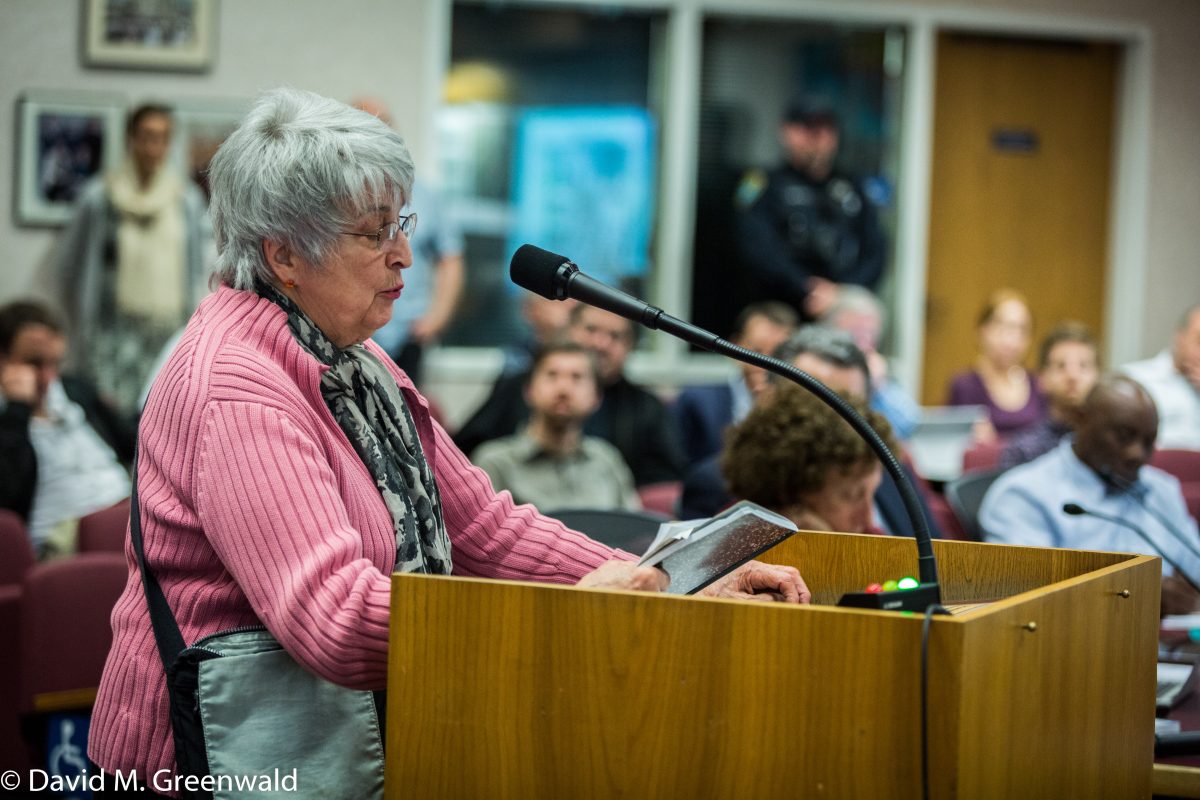
“This is not meant to exclude students,” he clarified.
Councilmember Will Arnold seemed to agree, “My appetite for this type of project has reached its satiation point.” He added, “Absent a geographic circumstance, such as spitting distance from campus, then I am inclined to support something like what you said.”
He said while he felt like the size of the apartments would be appropriate for his family, the structure might not. “Dougie needs not, nor should he have his own bathroom,” he said, referring to his young son.
Rochelle Swanson added, “I think it’s time to do a pivot.” At the same time, “We can’t expect it all to be across the street, we have a benefit from having students (in the city).” But she said, “I think being able to have a mix for the workforce… We begin to build new diversity into our housing, to mirror the old diversity that we had at one point.”
In her more general comments, however, she pointed out the New York Times article on shared housing for professionals and the changing nature of housing for people who are older than just the typical student population.
However, it is unclear as to how much agreement there was in this regard. Rochelle Swanson pointed out, “There could be times where it makes a lot of sense (to have student housing).”
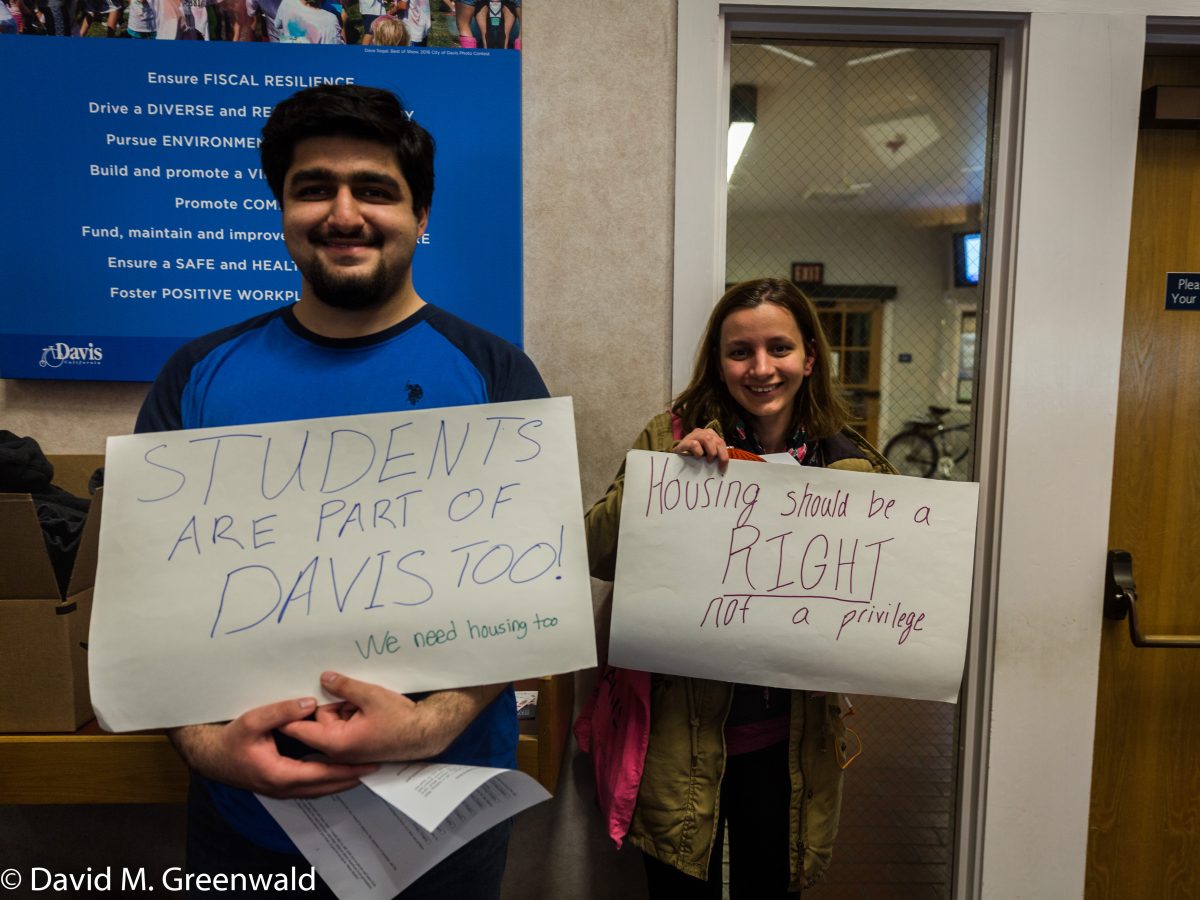
Lucas Frerichs stated, “I’m not willing to sign the Grover Norquist ‘no new taxes pledge.’” He said, “I think that making blanket statements that we shall or shall not do something, I’m not sure that’s something that either I or our colleagues should be doing.”
He added that part of this is “the need for the university to be doing what they should have been doing all along which is building a bunch of housing on campus.” But he added, “It’s not a zero sum game, where you only wait for the university to do what they should have been doing all along.”
Councilmember Frerichs pointed out that the sad part of the university not doing their share is that “as much as we’re hearing about the mega-dorms issue, we’re also on the flip side hearing equally about the mini-dorms issues” where many students are living in large numbers in single-family homes intended for families.
“If the location is right, I’ll go for dense, and student housing makes sense,” Mayor Robb Davis said during his comments.
Earlier in his more general comments, Councilmember Lucas Frerichs pointed out that “Lincoln40 provides density where we need it.”
He said, “A wide range of housing is needed.”
He added, “Is it student oriented? Yes. I don’t think that’s the worst thing ever.” He made it clear however, that it wasn’t the only thing we need.
“Housing is a shared responsibility,” Councilmember Frerichs said. “UC Davis needs to do more housing… It’s frankly not a zero sum game.” He added, “I think we ought to do our sharing of building some housing.”
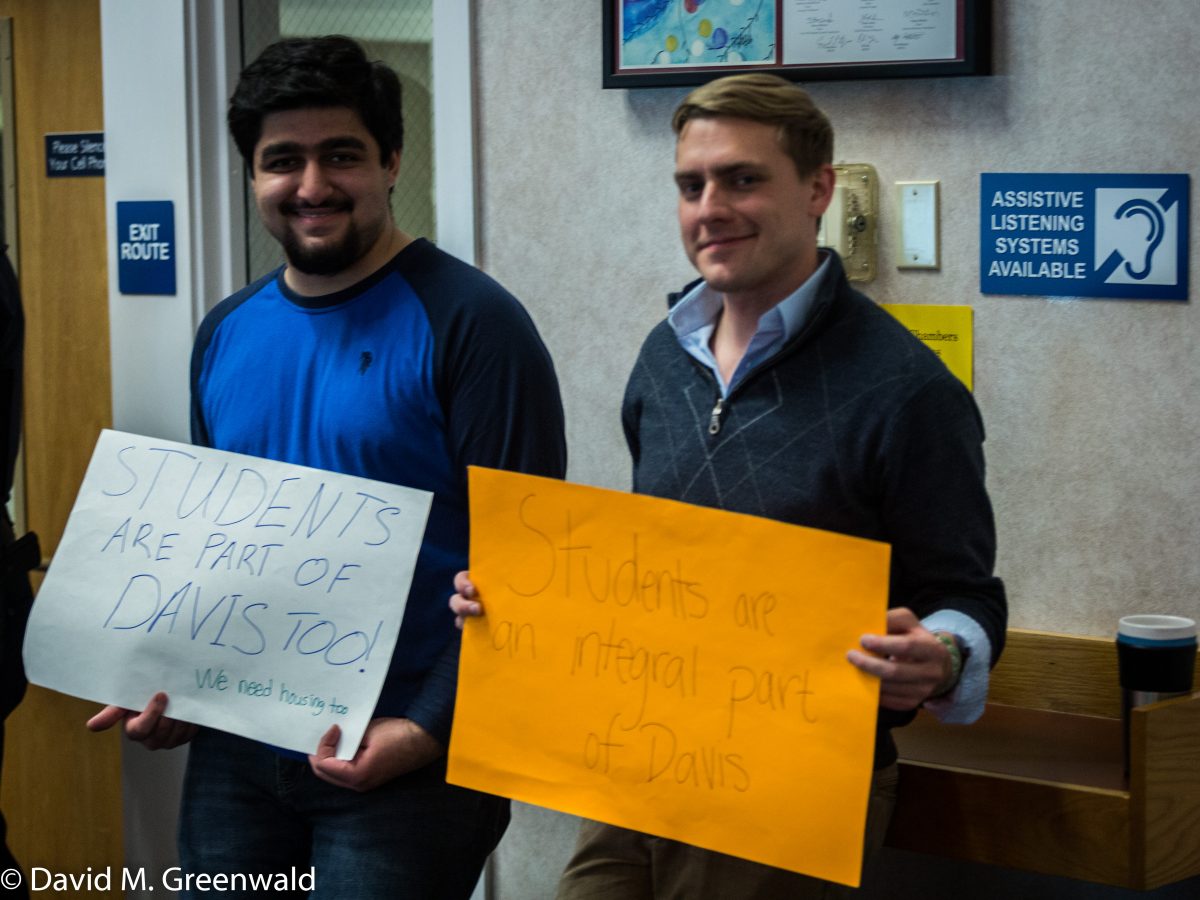
Councilmember Will Arnold said, “Folks are begging us for roofs over their heads.”
“In terms of the four and five bedrooms, I completely understand the concern that we ought to have a diversity of housing types in town, it’s a concern that I share,” he said.
He related a conversation where the person said, “We should build housing including affordable housing for our residents, and not possible future residents.”
He found that odd. He said, “My response was, no matter how long you’ve lived in Davis, the college student as a cohort of folks has lived here longer. The names and faces may change, but the college student is and always has been and God willing always will be an essential part of this community long after we’re gone.
“We’re not serving this essential part of the population,” he said. “And we can do better.”
Mayor Robb Davis addressed the role of the university in providing housing. He said that in addition to the resolution on housing on campus passed by this council, “My very first meeting with the new chancellor was about this issue, at his request.”
He wanted to know what the city was asking for and what the city is doing. Mayor Davis said, “To be able to put my foot forward and say, these are the types of projects we’re working on… I’m going to say was critical to saying to the university that this is a serious community that wants to be a partner in solving the problem.”
Mayor Davis pointed out, “The result is that the university hasn’t backed off its agreement to give more.”
The council vote was 5-0, and council has now approved its third student housing project in the last year, with Nishi once again pending a Measure R vote in June.
—David M. Greenwald reporting







“Rhonda Reed, Linda Deos, Donna Russell, Nancy Price and Eileen Samitz spoke out against the project with no opposition coming from the neighborhood.”
It was interesting to me that with one exception in the individuals you have named, there was not so much opposition to the Lincoln40 project, but rather reasonable considerations for options that might have provided a better project. I heard these as much as preferences for future projects as I did criticisms of this one.
I appreciate that the City Council chose to acknowledge in both words and actions the importance of early and frequent collaboration, not only with city staff, but also with the community at large and the affected neighborhoods. I sincerely hope that this will prove to be the model adopted by future developers and will come to be the model expected by future councils.
I am concerned with the sign that reads “Students are apart of Davis.” It does seem to fit in with the recent political tweet re. Tillerson that he has “severed our country well,” however.
But I digress….
Now that the project has been approved, my biggest hope is that it will inspire and create practical car-free transportation options for every resident in this area–to reach downtown, campus, and South Davis easily and conveniently.
There were a lot of helpful (mostly expected) things in the final agreement – e.g. on-site subsidies instead of in-lieu, very gentle-persons agreement on flexible housing from now on with student-focus when appropriate and more $$$ for the crossing of the train tracks.
How much these can mitigate or repair certain core aspects is unclear:
First of all, the un-subsidized per bed cost is according to my analysis way above market, at least 25% compared to upper class… upper case “S”-shared rooms and at least 50% more than lower case “s”-shared, even taking into furniture, utilities, etc. More details here in my comment from yesterday. So there’s a subsidy – yes, that’s great! – but for an over-inflated price.
Second, the crossing as currently envisioned as it’s both poorly-conceived – it can be way more useful in aggregate with the Old 40-Pole Line connection as the route from much of South Davis to Downtown — it can be almost entirely conflict-free with cars as it links with low-capacity Greenbelt paths and hopefully well-designed higher-capacity Class IV biketracks on streets in South Davis. Lucas Frerichs correctly ascertained same – though from what Robb Davis said earlier about SACOG’s view I’m sure everyone’s all-grokked about it – but the problem is that the favored-design has a double-loop on the northern side of the tracks that lands at the east end of the parking lot. This double-loop design is certainly ADA-compliant but difficult to ascend and descend by faster (and mostly non-motorized) bicycles. (I’ve pushed hard for the Old 40-Pole Line to not have a similarly-awkward double switchback and apparently a straight ramp alternative – similar in functionality to all but more so the south side of the Dave Pelz bike-ped bridge – will be presented at the Bicycling, Transportation and Street Safety Commission in April.)
The thing is it’s way more useful for general bicycle (and pedestrian; mobility-impaired) travel between South Davis then it is for travel to the train station. The landing area is near the existing BikeLink lockers (and possibly the new ones that will accommodate long tail bikes but tragically not larger cargo bikes or bikes with trailers, etc – this is like the main parking lot not allowing SUV’s, which would cause a riot) but that’s a poor choice for a route through to Downtown. The double-loop is likely intolerable for cyclists and a much longer route than is necessary for pedestrians and people in wheelchairs. If the over-crossing is the only possibility – and my understanding is that Union Pacific will not budge on this (or did I miss something at yesterday’s Council meeting?) there should be a large elevator – big enough for a lot of people and long enough for a bicycle with trailer or larger cargo bike – and possibly also a tight staircase. (On the south side, the long ramp is okay either above or below the tracks but best would be a solution that also attaches directly to the Lincoln 40 building at its 3rd or 4th floor with bike-parking here, too, so that residents don’t have to go down and up and down to get to the train station — perhaps if there’s already an elevator planned for the north side of the building this can be achieved without a lot of work. The developers seem to understand the usefulness of the crossing, and this can make them seem like geniuses even if I get all the credit.)
The elevator (and possibly stairs) and possibly the double-loop solve the to-the-train connection but what to do for Downtown? A landing in the east end of this parking lot – furthest from the street – with it seems little chance for a safe separated path closer to e.g. 2nd St or even better 3rd St. can be solved in one or more of several ways:
1) Adding a secondary path over the parking lot that lands either at the current location of the electric-car charging stations in the west end of the lot on the north side of the entrance.
2) Closing the parking lot* to all but ADA and taxi/ridehail – and positioning the landing outside and to the northside of the loop needed for these vehicles to enter and leave the station area in the smallest space possible.
2a) Closing the parking lot* as above but instead of e.g. green space here build a tax-income-producing commercial building that’s well-suited for this location – with a cafe that’s a nice spot to wait for trains (an existing business near 2nd and H can move over here) a restaurant also focused on rail passengers, a indoor-outdoor venue that can make a certain amount of noise as there aren’t residences immediately adjacent – and attach the bridge structure to it (with direct egress, too – bike parking over grade would be useful too for South Davis people to avoid unnecessary under-over-under).
3) With Union Pacific-consent have the path over the lot also go over the secondary freight-rail tracks with a landing just near 3rd St., thus connecting directly to the best choice east-west bicycle corridor between UCD campus and Old East Davis (eventually to whatever’s developed in the PG&E area.)
All of this stuff – outside of the commercial building – will likely cost a lot more than what’s currently conceived, but it adds huge value for sustainable transportation (and above requirements for ADA) and will likely make SACOG (and other entities) scream for the opportunity to fund it!!
Finally, it doesn’t seem that any of the suggestions I made for parking mitigation were incorporated into the development agreement. That’s unfortunate — again, the main argument for the approved “compromise” of a couple hundred parking spaces is based on the odd idea that no or less parking would create “parking hardship” in the area that could very easily be solved with the existing parking permitting mechanisms in the City.
* The parking lot produces no direct income for the City, wastes precious space at its core, and is only useful for car drivers – including from the Natomas, as is well-known – who take the first train (or trains) to the Bay Area or jobs that start early. It’s inequitable at best. Parking access to train station should be primarily by foot, bike, wheelchair, taxi (ride hail) and bus, with peripheral parking both in the 4th St. parking structure and either the 1st and F St. parking structure – or even much better – a peripheral lot on the south side of the train tracks that’s part of the 80-Richards and bus/HOV lane projects, adding a regional bus connection there – all connected by cheap running cost, 24/7/365 self-driving electric-shuttles on fixed routes (Transdev, the company that runs Yolobus for the Yolo County Transportation District, operates similar systems already.). With the parking lot on the south side of the tracks the 1st and F St. parking structure can also be made into a tax-producing venue!)
In this article, you do not represent accurately what I said last night at the City Council meeting.
I did not state that I oppose the project. What I did say, was that the applicant had noted the “Z” generation was environmentally aware. Therefore, I commented that because this is such a large project that the applicant, the City Council and the student support that building materials be green and recycled and are sourced locally and regionally and “Made in America.”
That is all I said. Please listen to the tape of the meeting and for the record correct the caption under the photograph that accompanies the article above.
Thank you,
Nancy Price
I’m wondering if Nancy is coming out to publicly “support” Lincoln 40 (since if she is still opposed to Lincoln 40 the caption is correct).
Sometimes, KA, people see a trend, or say ‘good enough’, or decide to pick their battles, or even change their mind. Without attempting mind reading, why don’t you just go with what she said last night, and take it for what it is . . .
And then there’s the rest of the story. I was in the back, taking photos of the students holding signs, and Nancy walked in and asked me if I was planning to get photos of the opposition as well. And I said, well if they had signs and she said, so we need to have signs for you to photograph us or something to that effect. I’m fairly sure she had spoken out against the project at the social services commission meeting, so the caption accurate even if the content of her speech non-oppositional.
Lesson here is: anything you say to DG is on the record.
Particularly if the ‘source’ initiates the conversation, and makes no apparent request for anonymity…
On the record: https://rethinkmedia.org/blog/on-record-off-record-on-background-and-not-attribution-explained
David… thank you for the primer…
The other thing is that I probably wouldn’t normally post about a conversation like that except she implied that I had my facts wrong.
I’ll back you up on this. Not that you need backing up, it’s all on the tape — but few will watch that.
You weren’t the only one who was cast as opposed who really didn’t say that. I believe DG is calling anyone who didn’t come out and glowingly support the project “opposed”. Certainly some had issues with aspects or effects of the project or in city trends — but that’s not the same as opposed.
Since there’s actually a picture of you captioned “opposed”, I’d demand a retraction. Oh, I just re-read — you did. I hope you get it.
I beg to differ with you David. Your backstory makes for a good story, You have, however, no knowledge of my final opinion about the project and should not make such an assumption in your caption.
Grant your point on the caption. Do you categorically affirm the conversation, including contents, though?
gran